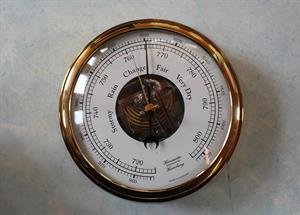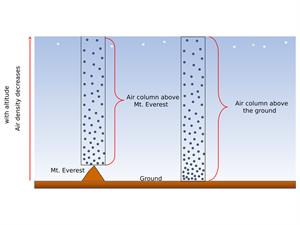PDF chapter test TRY NOW
Atmospheric pressure is the amount of force exerted by the air surrounding us downwards upon the earth's unit surface.
- The space around us is filled with air and dust particles.
- This layer of air surrounding the earth's unit surface area is called the atmosphere. Atmospheric air extends many kilometres above the earth surface.
- The pressure exerted by this layer of air upon the surface of the earth is called atmospheric pressure. This atmospheric pressure is also called barometric pressure because a barometer is used to measure the pressure.
- Scientists measure atmospheric pressure with the help of a mercury barometer. A mercury barometer is made up of a glass tube placed upside down inside a beaker filled with mercury.

Barometer

Variation of pressure near the ground level
The above image shows the variation of pressure near the ground level and the region above the ground level. Since the particles are more near the ground, the pressure at the ground level will be higher, while the pressure above the ground level will be lower.

When we press the sucker against a surface, most of the air that presents between its cup and the surface escapes. The sucker sticks to the surface because the atmosphere's pressure acts on it. To remove the sucker from the surface, one must apply a force large enough to overcome the atmospheric pressure.

In the above diagram, the weight of air in a column of the height of the atmosphere and area 10 cm × 10 cm is as large as 1000 kg.N). We are not crushed under this force of gravity because our bodies' pressure is equal to the atmospheric pressure that balances the pressure from outside.
Reference:
https://commons.wikimedia.org/wiki/File:Aneroid_Barometer.jpg
